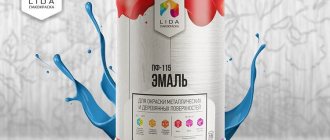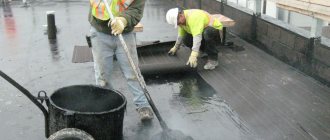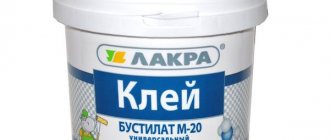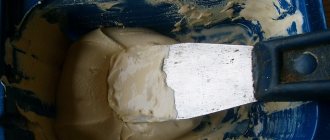BRANDS AND TECHNICAL REQUIREMENTS
1.1. Depending on the recipe and purpose, putty is produced in several brands (Table 1).
| Brand | OKP code | Compound | Purpose |
| MS-006 pink | 23 1294 0119 08 | A mixture of pigments, fillers and alkyd styrene varnish | For correcting minor defects on primed metal and wood surfaces and on primed and enamel surfaces |
| ХВ-004 green gray | 23 1314 0108 08 23 1314 0103 02 | A mixture of pigments, fillers and a solution of polyvinyl chloride resin in organic solvents with the addition of a plasticizer | For leveling and correcting defects of primed metal and wooden surfaces, for straightening the revealing enamel layer |
| NTs-008 red-brown protective gray | 23 1414 0258 10 23 1414 0211 03 23 1414 0203 03 | A mixture of pigments, fillers and a solution of colloxylin in organic solvents with the addition of a plasticizer and oils | For leveling and correcting defects of primed metal and wooden surfaces, for straightening the revealing enamel layer |
| NTs-0038 white gray | 23 1414 0401 23 1414 0403 | Suspension of pigments in a mixture of colloxylin, resin in organic solvents with the addition of plasticizers | For leveling and correcting wooden surfaces when finishing them (for furniture and other products) |
| PF-002 red-brown | 23 1224 0158 10 | A mixture of pigments and fillers in pentaphthalic varnish with the addition of organic solvents | For leveling and correcting defects of primed metal and wood surfaces |
1.2. Putties are manufactured in accordance with the requirements of this standard according to recipes and technological regulations approved in the prescribed manner.
1.3. Characteristics
1.3.1. Putties XV-004, NTs-008, MS-006, PF-002 are applied with a spatula or by pneumatic spraying, putty NTs-0038 is applied with a spatula or by pouring.
1.3.2. To dilute the XB-004 putty, use solvents R-4, R-4A or R-5, R-5A in accordance with GOST 7827, putties NTs-008, NTs-0038 - solvents 645 or 646 in accordance with GOST 18188, putties MS-006 - xylene according to GOST 9410 or GOST 9949, putties PF-002 - white spirit (nefras-S4-155/200) according to GOST 3134, turpentine according to GOST 1571 or a mixture of white spirit with solvent according to GOST 1928 or GOST 10214 in a ratio of 1:1 (by weight).
1.3.3. Putties must meet the requirements given in Table 2.
table 2
| Indicator name | Standard for putty brand | Test method | |||||||||||
| PF-002 | MS-006 | ХВ-004 | NTs-008 | NTs-0038 | |||||||||
| red-brown | pink | gray | green | gray | protective | red-brown | white | gray | |||||
| 1. Color of the putty coating after drying | Shade is not standardized | Based on approved color samples | According to clause 3.3 | ||||||||||
| 2. Appearance of the putty coating after drying | The surface of the putty coating must be smooth, uniform, without bubbles, scratches, cracks and mechanical inclusions | According to clause 3.4 | |||||||||||
| 3. Drying time to degree 3, hours, no more: | According to GOST 19007 and clause 3.5 of this standard | ||||||||||||
| at temperature (20+2) °С | 24 | 0,25 | 2 | 2 | 2,5 | 2,5 | 2,5 | 3 | 3 | ||||
| at a temperature of 80-85 °C | 1 | — | — | — | — | — | — | — | — | ||||
| 4. Degree of grinding, microns, no more | 90 | 75 | — | — | — | — | — | — | — | According to GOST 6589* | |||
| ________________ * The document is not valid on the territory of the Russian Federation. GOST R 52753-2007 is valid. — Note from the database manufacturer. | |||||||||||||
| 5. Conditional viscosity of putty at temperature (20.0+0.5) °C, s: | |||||||||||||
| according to VZ-246 (or VZ-4), nozzle 4 mm, s, no less | — | 19 | — | — | — | — | — | — | — | According to GOST 8420 and clause 3.6 of this standard | |||
| according to VZ-246, nozzle 6 mm, with | — | — | 20-45 | 30-70 | 30-80 | 30-80 | 30-80 | 30-70 | 30-70 | ||||
| according to VZ-1, nozzle 5.4 mm, with | — | — | 35-60 | 50-100 | 50-120 | 50-120 | 50-120 | 50-100 | 50-100 | ||||
| 6. Penetration at temperature (25.0+0.5) °C, 10 mm | 250-350 | — | — | — | — | — | — | — | — | According to GOST 5346 | |||
| 7. Putty running off a vertical surface | Doesn't drain | — | — | — | — | — | — | — | — | According to clause 3.7 | |||
| 8. Mass fraction of non-volatile substances, %, not less | 75 | 80 | 67 | 60 | 70 | 70 | 65 | 63 | 63 | According to GOST 17537 and clause 3.8 of this standard | |||
| 9. Sandable | Sandable with water | Sands without water | According to clause 3.9 | ||||||||||
| 10. Heat resistance at a temperature of 65-70 °C, h, not less | — | — | — | — | — | — | — | 8 | 8 | According to clause 3.10 | |||
| 11. Elasticity when bending, mm, no more | 100 | 100 | 50 | 50 | 50 | 50 | 50 | — | — | According to clause 3.11 | |||
| 12. Impact strength on the U-1 device, cm, not less | 20 | 50 | 30 | 30 | 30 | 30 | 20 | — | — | According to GOST 4765 and clause 3.12 of this standard | |||
Note. The standard for indicator 5 for a viscometer type VZ-246 with a nozzle diameter of 6 mm is not rejected until 01/01/93. The standard for indicator 5 for a viscometer type VZ-1 is valid until 01/01/93. When determining the appearance, the presence of scratches for MS-006 putty is not considered a rejection.
1.3.4. Safety requirements
1.3.4.1. Putties are toxic and flammable materials.
The toxicity and fire hazard indicators of the components are given in Table 3.
Table 3
| Component name | Maximum permissible concentration of vapors of harmful substances in the air of the working area of industrial premises, mg/m | Temperature, °C | Concentration limits of ignition, % (volume fraction) | Hazard Class | ||
| flashes | self-ignition | lower | upper | |||
| Styrene | 5 | 30 | 530 | 1,10 | 5,2 | 3 |
| Dimethylaniline | 0,2 | 53 | 400 | — | — | 2 |
| Xylene | 50 | 21 | 450 | 1,00 | 6,0 | 3 |
| Toluene | 50 | 4 | 536 | 1,30 | 6,7 | 3 |
| Acetone | 200 | Minus 18 | 500 | 2,20 | 13,0 | 4 |
| White Spirit | 100 | 33 | 270 | 1,40 | 6,0 | 4 |
| Ethyl acetate | 200 | Minus 3 | 400 | 3,55 | 16,8 | 4 |
| Butyl acetate | 200 | 29 | 370 | 2,20 | 14,7 | 4 |
| Ethanol | 1000 | 10 | 404 | 3,60 | 19,0 | 4 |
| Butyl alcohol | 10 | 34 | 345 | 1,70 | 12,0 | 3 |
| Isobutyl alcohol | 10 | 28 | 390 | 1,84 | 7,3 | 3 |
| Solvent | 100 | 20 | 553 | 1,30 | 8,0 | 4 |
| Turpentine | 300 | 34 | 300 | 0,80 | — | 4 |
1.3.4.2. When producing and using putties, the rules of industrial sanitation and fire safety in accordance with GOST 12.3.005 must be observed.
1.3.4.3. All work related to the production and use of putties must be carried out in workshops equipped with supply and exhaust ventilation and fire-fighting equipment in accordance with GOST 12.1.005.
1.3.4.4. Persons associated with the production and use of putties must be provided with personal protective equipment in accordance with GOST 12.4.011.
1.3.4.5. Fire extinguishing agents in the production and use of putties: sand, felt, carbon dioxide fire extinguishers OU-2 or OU-5 according to NTD, foam fire extinguishers OHP-10 or OVP-100, fire extinguishers OP-05, foam installations, inert gases.
1.3.4.6. During the production of putties, solid, liquid and gaseous wastes are generated, which can cause air and water pollution.
Monitoring compliance with maximum permissible emissions (MPE) must be carried out in accordance with GOST 17.2.3.02.
All solid and liquid waste generated after filtration, washing of equipment, communications, cleaning of paint booths in the form of contaminated solvents and used filters must be collected in special tankers and containers, promptly removed and disposed of in accordance with the procedure for accumulation, transportation, neutralization and industrial waste disposal.
1.4. Marking
1.4.1. Marking of putties is in accordance with GOST 9980.4*.
________________
* The document is not valid on the territory of the Russian Federation. GOST 9980.4-2002 is in force. — Note from the database manufacturer.
1.4.2. The transport container must be marked with a handling sign “Keep away from heat” in accordance with GOST 14192, a danger sign and a classification code for group of dangerous goods 3212 in accordance with GOST 19433, serial number UN-1139.
1.5. Package
1.5.1. Putties of all brands are packaged in accordance with GOST 9980.3.
1.5.2. Metal cans with putty intended for retail distribution may be packaged in boxes made of solid glued cardboard.
Types of putty
Types of putty are determined by method of application:
- Leveling (starting) - has a large fraction of filler, allows you to work with a large layer thickness, is used for forming slopes, leveling walls, ceilings, openings. It has high adhesion, which is very useful for subsequent finishing with other materials. The average layer thickness ranges from several millimeters to 2-3 cm.
- Finishing putty is more flexible, more durable, and is used to perfectly level the surface before wallpapering, applying decorative plaster, or painting. The average thickness of the applied layer can be 0.2-1 mm, which is enough to fill the pores after using the starting putty. Due to the fact that the composition uses a filler with a smaller fraction, it easily fills pores and irregularities after using the “start”, and well levels out scratches and minor defects in putty work. In some cases, sequential application of several layers of finishing putty is required to achieve the best finishing effect on walls or ceilings. It is convenient to use it on drywall, but for work on cement-sand plaster, finishing putty is rarely used due to its high consumption. Please note that the strength of the dried putty is significantly higher than the starting putty, so for surfaces with intensive use it is advisable to use the finishing putty. Disadvantages include high price, difficulty in grinding, high setting speed. The finished surface has a polished appearance; sometimes, after completing the painting work, no further finishing is required. In some cases, coloring compounds are also added to the finishing putty to create the effect of decorative, textured plaster.
- Universal putties - medium fraction size and average strength ensure low cost and versatility of use of the material. It is useful to use such solutions for minor differences in height, if the budget is limited, to strengthen the base. Less commonly, putty of this category is used when laying gypsum blocks and when decorating surfaces. It is durable enough for use in residential and commercial buildings, and overall budget savings can be 20-30% compared to multi-layer start and finish finishes.
- Special-purpose putties are building materials that have distinct specific characteristics (elasticity, heat and sound insulation, vapor permeability, high strength). They can be used at the junction of various materials to compensate for linear expansions, for surface reinforcement, covering vibrating units and other special tasks. Prices for such putties vary greatly depending on their composition and properties.
Of the entire list of putties listed, two types are used everywhere in residential construction: gypsum and cement putties.
- Gypsum does not shrink, is ideal for use in residential premises, helps regulate the indoor climate, and has a low cost. Disadvantages - low strength, high putty consumption, poor resistance to moisture, can be a breeding ground for fungi, mold and other microorganisms.
- Cement has increased strength and can withstand prolonged contact with water. Disadvantages - the cost is higher than that of gypsum putties, the material shrinks, which can lead to the formation of defects in the form of microcracks on the surface after drying.
Please note that the key property of various types of putties is the filler used, or rather its dispersion. Coarse solutions have a grain size from 80 to 200 microns, medium-fine solutions have a grain size of 20-80 microns, and “fine” putty contains components with a grain size of up to 20 microns.
TEST METHODS
3.1. Sampling - according to GOST 9980.2.
Before testing, putty samples in tightly closed containers are brought to a temperature of (20±2) °C.
3.2. Preparing samples for testing
3.2.1. For NTs-0038 putty, all indicators are determined on wooden plates measuring 70x150 mm and 5-10 mm thick.
For putties of other brands, the elasticity of the putty coating during bending is determined on plates made of black tin according to GOST 13345 with dimensions of 70x170 mm and a thickness of 0.25-0.32 mm. The remaining indicators are determined on plates made of steel grades 08kp or 08ps according to GOST 16523, size 70x150 mm and thickness 0.8-0.9 mm.
Plates for applying putties are prepared in accordance with GOST 8832, section 3.
To apply putties PF-002, MS-006, HV-004 and NTs-008, use plates pre-primed with GF-021 primer according to GOST 25129 or GF-0119 according to GOST 23343, or other interchangeable primers. After drying, the surface of the primer is sanded with sandpaper with a grain size of 4-6 in accordance with GOST 6456 or GOST 10054.
In case of disagreement in assessing the quality of putties, GF-021 primer should be used.
3.2.2. MS-006 putty is applied to the plates with a spatula without a stencil. The thickness of the putty coating after drying should be 40-50 microns.
The remaining putties are applied to the prepared plates with a spatula using a special device.
The device for applying putties (Fig. 1-4) consists of a steel plate to which four brackets with thrust wings are attached, a pressing steel frame and metal stencils of various thicknesses. The surfaces of the plate and frame must be sanded.
Putty application device
Damn.1
Damn.2
Damn.3
Damn.4
The prepared plate is tightly clamped between the plate and the stencil using a frame and thrust wings, and putty is applied to it with a metal spatula to the edges of the stencil, removing the excess. The size of the cutout in the stencil is 50x130 mm.
When applying putties XB-004 and NTs-008, a stencil with a thickness of 0.3 mm is used, putties PF-002 - a stencil with a thickness of 0.5 mm. The thickness of the putty coating after drying should be no more than 120 microns for NTs-008 putty, no more than 150 microns for XV-004 putty, and no more than 400 microns for PF-002 putty.
When applying NTs-0038 putty, a 0.5 mm thick stencil is used to determine the color, appearance, drying time and ability to be sanded. The thickness of the putty coating after drying should be 100-150 microns. When determining heat resistance, NTs-0038 putty is applied over a 1.5 mm thick stencil. The thickness of the putty coating after drying should be no more than 500 microns.
The putties are dried at the temperature and for the time specified in Table 2. To determine the heat resistance of NTs-0038 putty, samples are dried at a temperature of (20±2) °C for 6 hours. To determine the bending elasticity of PF-002 putty, samples are dried at a temperature of (20±2) °C for 24 hours, after drying The surface of the putty is sanded with sandpaper with a grain size of 4-6 according to GOST 10054 when wetted with water and kept in air at a temperature of (20±2) °C for 1 hour.
Before hot drying, the plates with PF-002 putty applied are kept at a temperature of (20±2) °C for 3 hours. After hot drying, the plates are cooled to a temperature of (20±2) °C.
The thickness of the putty coating is measured with a micrometer type MR according to GOST 4381.
3.3. The color of putties is determined visually in artificial or natural diffused light. The color of NTs-0038 putty is determined by comparison with approved control color samples.
3.4. The appearance of the putty coating after drying is determined visually by inspecting the surface before and after grinding under artificial or natural diffused light. Grinding is carried out (without the use of water) with sandpaper with a grain size of 4-6 in accordance with GOST 6456 or GOST 10054.
In case of disagreement, the color and appearance of the putty coating is determined in natural light.
3.5. The time and degree of drying are determined according to GOST 19007.
When determining the drying time, it is allowed to remove the paper in any way that does not lead to visible damage to the putty coating.
3.6. The viscosity of putties is determined according to GOST 8420.
Before determining the viscosity, putties are diluted with solvents.
Putties XB-004, NTs-008 and NTs-0038 are diluted with acetone according to GOST 2768 in a weight ratio of 4:1, respectively.
MS-006 putty is diluted with xylene in accordance with GOST 9410 or GOST 9949 in a weight ratio of 5:1, respectively.
3.7. The flow of PF-002 putty from a vertical surface is determined visually on one sample. To do this, the plate with the putty applied is installed in a vertical position (along the length of the plate) and kept at a temperature of (20±2) °C for 30 minutes. The putty should not run off.
3.8. The mass fraction of non-volatile substances is determined according to GOST 17537, clause 1.4.4.
Samples of putties PF-002 and MS-006 are heated in a drying cabinet at a temperature of (140±2) °C, samples of putties XV-004, NTs-008 and NTs-0038 are heated in a drying cabinet at a temperature of (105±2) °C.
The first weighing is carried out after 1 hour of drying, subsequent weighings are carried out every 30 minutes until a constant weight is achieved.
It is possible to determine the mass fractions of non-volatile substances under an infrared lamp at the same temperatures.
In case of disagreement in the assessment, the result of the determination carried out in the drying cabinet is taken as final.
3.9. Determination of sandability
The test is carried out on one sample. After drying, the surface of putties PF-002, MS-006, XV-004 and NTs-008 is sanded with waterproof sandpaper with a grain size of 4-6 according to GOST 10054.
Grinding is carried out evenly over the entire surface, wetting it with water. After sanding, the surface of the putty is washed with water and wiped dry with a soft cloth.
The putty complies with this standard if, when sanded for 15 minutes, it does not become wet and a smooth matte surface is formed.
The surface of the NTs-0038 putty is sanded using sandpaper with a grain size of 4-6 using the dry method. Light salting of the skin is allowed.
3.10. Determination of putty heat resistance
Three plates with NTs-0038 putty, prepared in accordance with clause 3.2.2, are placed in a drying cabinet and kept at a temperature of 65-70 ° C for 8 hours, then removed, cooled for 2 hours and inspected.
The putty coating should not have cracks visible to the naked eye.
3.11. Determination of bending elasticity
The elasticity of the putty coating during bending is determined using the device shown in Figure 5.
Device for determining the elasticity of putties when bending
Damn.5
The device consists of a metal plate to which half-cylinders with a diameter of 100 and 50 mm are attached, a movable frame with a pressure roller for pressing the plate to a cylindrical surface, a fastening screw and a wooden stand.
The plate is secured at one end to the device using a fastening screw and, when the frame is lowered to a horizontal position, it is pressed with a roller to a cylindrical surface.
The test is carried out on three samples. The prepared samples are kept for 2 hours in a drying cabinet: putties XV-004, NTs-008 - at a temperature of 60-70 °C, putty MS-006 - at a temperature of 90-100 °C. Then the plates are removed and cooled for 30 minutes.
Putties are considered to comply with this standard if cracks visible to the naked eye do not form on their surface when bent along a half-cylinder of 100 or 50 mm. Cracks at a distance of up to 15 mm from the edges of the putty coating are not taken into account.
3.12. Determination of impact strength
The strength of the putty coating upon impact is determined according to GOST 4765 using a U-1 type device. Before testing, samples of putties KhV-004 and NTs-008 are kept in a drying oven at a temperature of 60-70 ° C for 2 hours, followed by cooling for 30 minutes.









